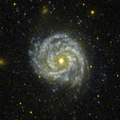Messier 100
| Galaxy Messier 100 / NGC 4321 |
|
|---|---|

|
|
| M 100 with NGC 4322 (lo) & NGC 4328 (lu) Uptake by the 1.5 m Danish telescope of La Silla Observatory of ESO |
|
| AladinLite | |
| Constellation | Berenike's hair |
|
Position equinox : J2000.0 , epoch : J2000.0 |
|
| Right ascension | 12 h 22 m 54.8 s |
| declination | + 15 ° 49 ′ 19 ″ |
| Appearance | |
| Morphological type | SAB (s) bc / LINER / HII |
| Brightness (visual) | 9.3 mag |
| Brightness (B-band) | 10.1 mag |
| Angular expansion | 7.5 ′ × 6.1 ′ |
| Position angle | 30 ° |
| Surface brightness | 13.3 mag / arcmin² |
| Physical data | |
| Affiliation | Virgo cluster Messier 87 group NGC 4639 group WBL 401 LGG 289 |
| Redshift | 0.005240 ± 0.000003 |
| Radial velocity | +1571 ± 1 km / s |
|
Stroke distance v rad / H 0 |
(68 ± 5) x 10 6 ly (20.9 ± 1.5) Mpc |
| history | |
| discovery | Pierre Méchain |
| Discovery date | March 15, 1781 |
| Catalog names | |
| NGC 4321 • UGC 7450 • PGC 40153 • CGCG 099-030 • MCG + 03-32-015 • IRAS 12204 + 1605 • KUG 1220 + 160 • 2MASX J12225489 + 1549205 • VCC 596 • GC 2890 • h 1211 • GALEX ASC J122254. 88 + 154919.1 • LDCE 904 NED074 • HOLM 387A • EVCC 467 | |
Messier 100 = NGC 4321 is an active barred spiral galaxy with extensive star formation from Hubble type SBBC in the constellation Coma Berenices the northern sky . It is an estimated 68 million light years from the Milky Way and about 155,000 light years in diameter.
It is listed as a member of the Virgo galaxy cluster under the catalog name VCC 596 and is located in its extreme northern part. Like almost all spiral galaxies, M 100 is located far from the densely populated center of the galaxy cluster. It is the brightest of the spiral galaxies in this cluster.
In the same area of the sky are u. a. the galaxies NGC 4312 , NGC 4322 , NGC 4328 , IC 783 .
Since their galactic plane is inclined more than 60 degrees from the line of sight, we have a very good view of the galactic disk. This makes it an ideal study object for all questions relating to spiral galaxies of the Virgo Cluster. In particular in the H 0 Key Project to measure the Hubble constant H 0 with the Hubble Space Telescope , M 100 was the first spiral galaxy in this cluster to be resolved into single stars. Within the scope of this investigation, Cepheids could be identified whose period-luminosity relationship could determine the distance from M 100 to 55 million light years . This distance is likely a little less than the distance to the center of the cluster.
The supernovae SN 1901B (Type I), SN 1914A , SN 1959E (Type I), SN 1979C (Type IIL), SN 2006X ( Type Ia ) and SN2019ehk were discovered here, with SN 1979C being exceptional because of its X-ray radiation, which is still present today .
M 100 is also the main galaxy of the small subgroup Holm 387 within the Virgo Cluster, to which mostly dwarf galaxies still belong.
Messier 100 with Supernova SN2019ehk
Link to the picture
(Please note copyrights )
High-resolution image of the center, Hubble space telescope
Ultraviolet absorption using GALEX
Messier 100 in the near infrared and in the millimeter range
discovery
The object was discovered on March 15, 1781 by the French astronomer Pierre Méchain .
Web links
- SIMBAD Astronomical Database
- Hubble Space Telescope
- Antilhue - Chile
- ESO: A Blast To Chase February 23, 2006
- M100
- astronews.com: The supernova that keeps glowing July 25, 2005
- astronews.com: Picture of the day July 29, 2013
- Spektrum.de : Amateur recordings [1] [2] [3]





